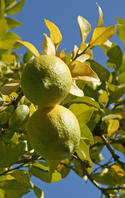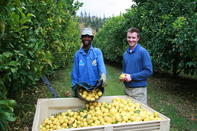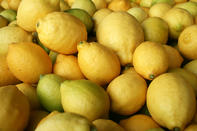
The Cape Rough Skinned Lemon is the oldest variety of lemons in South Africa. It was brought to the country from St Helen in 1654. Lemon trees were planted in the colony gardens of the Dutch East India Company, along with other fruit and vegetables to supply European traders with fresh produce en route to the East, where they bought spices and silk.
Lemon trees in Soth Africa were planted along pavements (sidewalks) in Kimberley during the Anglo-Boer war. An initiative to plant fruit trees in Soweto before the Soccer World Cup in 2010 revived the planting of citrus trees in gardens.
Lemon Production in South Africa

As maintained by the Citrus Growers Association in South Africa, the Eastern Cape is the biggest producer of lemons with 47% of the total area registered for exports in 2018.
Limpopo is the second-largest area, with 34% of lemon production, while the Western Cape is the third-largest area, at 11% of the total area under production that is registered for exports.
Lemon Varieties

Eureka is the most popular variety of lemon in the world and in 2018, it accounted for over 80% of the total area registered for lemon exports in South Africa.
The variety was originally named “Garey’s Eureka” by Thomas Garey, who in 1877 selected and propagated the bud wood from seedlings that came from Italy (probably Lunaria) and was planted in Los Angeles in 1858.
This variety has a smooth yellow skin, a high juice percentage and generally contains fewer seeds. Depending on climatic conditions and the production region, the fruit is usually picked from early to late winter.
Roughly 9% of the area was under Lisbon, while 4% was under Limoneira and 3% under Genoa. The Lisbon, as indicated by its name, originated in Portugal. It is the most cold-resistant of the top four varieties planted in South Africa and bears fruit that is slightly rougher and with a less pronounced nipple than Eureka.
The fruit is usually carried on the inside of the tree, which helps to shield the fruit against adverse weather and sunburn, which results in short harvest time.
The Limoneira comes from California. It is significantly more productive and has a lower seed content than the Eureka. Fruit reaches its optimal ripeness from April to July, depending on the production area. The trees can combine with a wide range of rootstocks.
The Genoa originated in Italy. It is an early variety that usually carries its fruit at the bottom of the trees, which helps to protect the fruit against sunburn and cold temperatures. The trees are without thorns and can be combined with a wide range of rootstocks.
The Agricultural Research Centre in South Africa developed the world’s first seedless lemon out of a Eureka mutation in 1998. The variety, called EurekaTM, however, never really took off as it proved to be less hardy and more harvest sensitive than the seeded varieties.
Lemon Production Season
The lemon production season runs from February to September, depending on the variety and climatic conditions in the lemon production region.